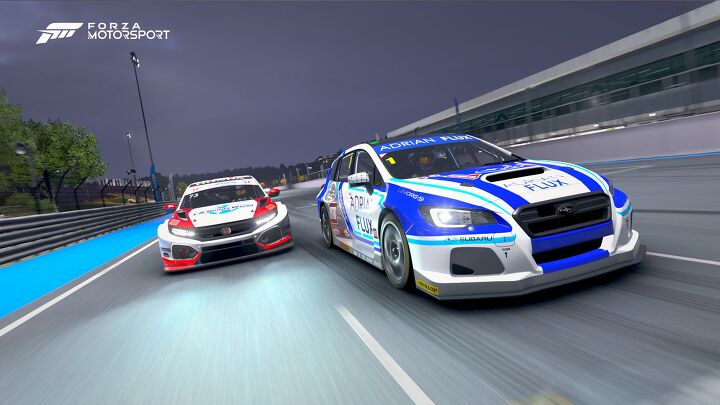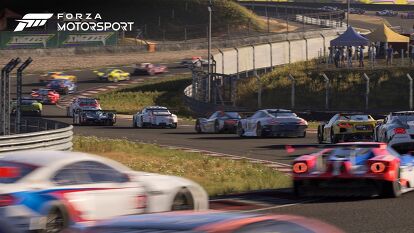Forza Motorsport Review: Racing Fundamentals


The weight of legacy creates some pretty hefty expectations.
“I see this as the spiritual successor to Forza Motorsport 4” says Forza franchise head honcho Dan Greenawalt. We’re standing in the comfort of a well-cooled room trackside at Spring Mountain Motor Resort, where Microsoft has brought in dozens of content creators and journalists to drive, both digitally and for real. With that, one of the co-founders of the franchise has swollen the expectations to full-on GMC Hummer levels of size. Amongst gaming circles, 2011’s FM4 is held up as the gold standard of the franchise, and a front-runner for best simcade racer, period.
Another factor: time. When Forza Motorsport launches on October 10, it will arrive a few days more than six years since the last title. That’s a lifetime in game development, and racing genre has evolved since—not just with the release (times two!) of erstwhile competitor Gran Turismo, but also with the Horizon sub-brand, which long overtook Motorsport as the big draw in Microsoft’s racing stable.
I’m happy to report that Motorsport has rediscovered its niche, putting clear distance between its more serious self and the fun-loving romp that is Horizon. The new title nails the fundamentals—a huge and diverse car list, satisfying physics, and a better online experience—but does little beyond that.
Full disclosure: Microsoft sent us a review code, and flew us to Vegas for a day's worth of fun at the track. Forza Motorsport releases October 10 for Xbox Series S and X, as well as PC. The Premium Edition unlocks the game five days early.

The cars are the stars
If FM4 is setting the pace, then this number-free instalment is already nosing ahead in qualifying. There are over 500 cars out of the box at launch, ranging from the almost-centenarian Bugatti Type 35 right through to the latest and greatest supercars. Players can once again explore them inside and out, placing their favorites in a swanky, well-lit studio. The number one pick even greets players at the start-up screen; a nice, personalised touch.
Anything that’s shown up in the last few years, either in the real world or in Horizon, is lovingly modelled in high-def glory. Some old favorites have returned too, but all the talk of a ground-up redo doesn’t extend to these (very) familiar faces. The Mitsubishi Eclipse’s single-color strip of flat red taillights ain’t fooling anybody: this is an Xbox 360-era model, pushing 20 years at this point. The sizeable quality gap amongst the car models is hard to overlook, either in the showroom or on the track.

Everything I’ve driven so far sure feels good, though. Be it a pointy Civic Type R, swinging ‘60s Camaro, or the planted, rear-biased 911 Carrera S. The physics tweaks are subtle but welcome: cars are generally pretty planted—just like real life—but how they relinquish grip once past the limit is now more gradual, more natural. One strength is just how satisfying it is to keep your ride mere inches from the others, as you barrel three-wide through the Nurburgring’s Schumacher S. Forza has long been a very controller-friendly experience, and my time with an Elite pad only reinforces this. (I can’t comment on the wheel experience, what with only a few minutes’ experience at the event and my own rig now being incompatible.)
Linear storytelling

One of the big changes to the progression formula comes from the decoupling of upgrades and credits. The latter is now solely for buying cars, which are largely priced based on performance, with a notable surcharge for historic relevance. On its own, this is great: the most expensive cars require a couple hours’ racing tops, and you can now pick a car based on what you actually want, not what’s cheapest. Looking at you, 20-million-credit cars in Gran Turismo 7.
Your rides now accumulate Car XP, levelling up in a not-so-transparent nod to Forza’s CarPG reputation. The official line is that this encourages players to get to know a car, from stock through its gradual improvements.

The reality is a grind. Every upgrade unlocks in the same order for every car, so there’s little experimentation. You’ll equip things as they unlock, unless you’re trying to stay under a certain performance level. More extreme measures like engine and drivetrain swaps—which erase the unique qualities of all these cars—unlock near the Level 50 cap, which keeps the craziness to a minimum. But no more buying a car and doing even light improvements before turning a few laps.
Where is everything?

The problem this modification approach runs into is that there just isn’t much to do in Forza Motorsport. The career mode is barebones: five leagues, each with four series consisting of four to six races. Races all fall into the same formula, with two or three practice laps and then a race maybe double the length. Practice is a great way to earn XP for your car, with tracks broken down into segments that reward bonuses when you improve your sector times. I personally like the ability to pick my grid placement for the race too, which rewards a further-back start with additional credits should you make the podium. It allows players to tailor each race to their tastes. But the basic gameplay loop gets old fast.
My experience with the AI left much to be desired. Even on the quicker settings, the computer-controlled cars would regularly randomly brake on straights. If not that, they’d take the line a karting novice would: inside all the time, and park on the apex. Your Car and Driver XP are both heavily weighted on following the racing line, so uh, good luck.

Making matters worse, most of the series limit you to a handful of eligible cars. For all its talk of wanting every player to have a different favorite 10 cars, Turn 10 sure has funnelled most selections into a narrow band. A Miata series, limited to just the two NA-generation models? How about four picks for the JDM legends event? Plenty of the cars only really make sense in the open class-based races, or custom events. For reference: I racked up over 2 million credits finishing up about half the campaign.
There isn’t much else to do, either, at least on your own. Multiplayer is still here, with both public and private lobbies. The former takes on a “race weekend” approach that is welcome, and finally adopts a robust driver safety and skill rating system. Rivals continues too, letting you earn credits (and Car XP) from chasing down the ghosts of other players. But there’s no drifting, anywhere. No Auction House—a Forza staple. There’s no discernible difference with the livery editor after almost 15 years, too. Also nixed: a central creator hub to see all your designs, replays, photos, and tunes. Tuning sees some gains and losses: now drivers can add ballast, but there’s no track width increases or even the ability to move around the car to see how those new wheels fit.
Track life

Within the context of this limited single-player experience, the track count isn’t much of a problem. Yes, Turn 10 has cut some absolute bangers—pour one out for Brands Hatch, Sonoma, and Road Atlanta—but there are some good additions. Kyalami and Mid-Ohio are both excellent tracks with good flow and plenty of passing opportunities. After some misses with previous fantasy tracks, Hakone and Grand Oak are both well done, too. Every one of them comes with fully variable time of day and weather, which can result in some spectacular visuals: a misty sunset run one race, and a torrential downpour to navigate the next.
Turn 10 has already confirmed more tracks are coming too, and for free. Up first is a remodelled Yas Marina in November, and the vaunted Nürburgring Nordschleife in spring.
Verdict: Forza Motorsport Review

It’s great that Motorsport is back, make no mistake. Horizon has leaned further and further into silly fun, but you can only launch a 1,500 horsepower Peel P50 off a mountain so many times. Turn 10 has built its own sandbox racer, one that refocuses the experience on close competition and the living, breathing nature of a race weekend. Now it just needs to add some more toys.
Become an AutoGuide insider. Get the latest from the automotive world first by subscribing to our newsletter here.

Kyle began his automotive obsession before he even started school, courtesy of a remote control Porsche and various LEGO sets. He later studied advertising and graphic design at Humber College, which led him to writing about cars (both real and digital). He is now a proud member of the Automobile Journalists Association of Canada (AJAC), where he was the Journalist of the Year runner-up for 2021.
More by Kyle Patrick
















































Comments
Join the conversation